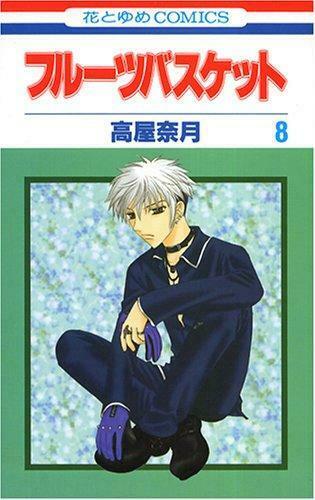Manga Review: Fruits Basket Volume 8 by Natsuki Takaya
Tohru Honda’s extended family sucks. After her mother died, her aunt and uncle made it clear they wanted nothing to do with the child. But the optimistic compassion and strong work ethic Tohru inherited from her mother served her well. She got a part time job as a cleaner, and moved to a tent in the woods.

However, it turned out that the forest was not public land, but the property of the wealthy Sohma clan, two of whom found her. A series of explanations later, Tohru became housekeeper for laid-back novelist Shigure Sohma (The Dog) and the two teenagers he was sheltering, the handsome but aloof Yuki Sohma (The Rat), and the hot-tempered Kyo Sohma (The Cat), in exchange for room and board.
This required Tohru to become aware of some of the Sohma family secrets, including the big one. Thirteen members of the Sohma clan are cursed by the Chinese Zodiac, and will turn into their totem animal when weakened or if embraced by a member of the opposite sex. “But wait,” you say, “aren’t there only twelve animals in the Chinese Zodiac?” Yes, and that’s just one of the points that makes the curse so pernicious.
Let’s drop in on the volume I have at hand, #8. Time is creeping on towards summer break, and the members of Tohru’s class are looking forward to a class trip. But there’s a more immediate issue, as Hatsuharu Sohma (The Ox) has slipped into his “Black” state and gone berserk. Turns out that his girlfriend dumped him when she went into the hospital, and he’s been bottling up his feelings until exploding.
Back at Shigure’s place, there’s a visit by Ritsu Sohma (the Monkey), who’s the child of the previously seen hot springs manager. Poor Ritsu has inherited his mother’s anxious disposition and tendency to apologize for anything he does or might somehow be connected to, even being born. For some reason, wearing women’s clothing calms him down slightly, so he always wears a fancy kimono and can easily be mistaken for a woman. Tohru doesn’t realize this until she accidentally turns him into his cursed form!
Ritsu and Tohru have a heart to heart about purpose in life, and Ritsu meets Shigure’s long-suffering editor Mitsuru, who he bonds with over their mutual anxiety issues.
The kids are reminded that parent-teacher conferences are coming up right after summer break; Yuki and Kyo aren’t too thrilled about the prospect due to their abusive home situations (they’re living with Shigure for good reasons.) Yuki’s flamboyant older brother Ayame Sohma (the Snake) offers to step in in place of their parents, but Yuki finds him embarrassing and not much better as a potential substitute.
For the first night of summer break, tiny Momiji Sohma (the Rabbit), drags Tohru and some of the other Sohma boys along on a trip to a haunted house. When Tohru (who is not good with fake scary stuff) has a panic attack, Hatsuharu tries to reframe the narrative, but winds up accidentally committing vandalism.
And in the stinger for the volume, we see that Rin Sohma (the Horse) is about ready to leave the hospital, but this may not be good news for Shigure….
Despite the light art style and the comedic moments, I’ve often said that this series is Gothic Romance. Impoverished but hopeful heroine, large wealthy family with many dark secrets, a romantic choice between the aloof heir apparent and the black sheep cousin, evil older person who runs/ruins the family–it just needs a cover with Tohru in a white nightgown running from a mansion with one lit window.
And indeed there’s a strong current of darkness under the pretty colors and fantastic elements here. Even the name of the series turns out to be a children’s game in which one child is targeted for ostracism. There’s child abuse, domestic abuse, emotional abuse, bullying, suicide and other tragedies in the backstory, so it’s no surprise that many of the characters are screwed up.
Most of these folks should be in therapy, but mostly it’s Tohru who winds up giving counseling, even though she herself desperately needs help.
Not much that’s plot-relevant happens in this volume. Ritsu’s story is self-contained, so all you’d be missing is an explanation of who he is when he returns towards the end of the series. There are two editions of the English adaptation; the Tokyopop volumes may be hard to find, but you should be able to get hold of the more recent Yen Press edition.
The characters are endearing, but some of the backstory is highly disturbing, so I’m going to say senior high on up, and maybe not for some sensitive readers.
There was a new anime version last year, please enjoy the opening!

